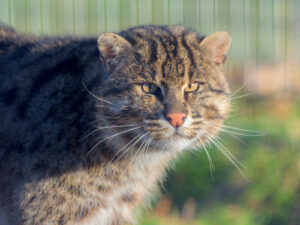Fishing Cats (Prionailurus viverrinus)
With its stocky build and short, muscular legs, the fishing cat exudes power. Twice the size of a domestic cat, fishing cats inhabit the marshes, swamps, and mangrove forests of South and Southeast Asia. Notoriously elusive, fishing cats are rarely seen in the wild, but these patient predators are uniquely adapted for aquatic life. Fishing cats play an important role in their ecosystems by keeping the populations of their prey, especially rodents, under control. Tragically, these grey spotted cats are threatened with increasing habitat destruction and human persecution, and as a result, are disappearing at an alarming rate.
Did you know?
These primarily nocturnal cats love water and have physical adaptations that make them formidable aquatic hunters. Partially webbed feet propel them through the water while their short, muscular tail acts as a rudder. When hunting from the bank, semi-retractable claws keep them anchored to the shore and a double coat of fur keeps them dry and warm while swimming. Large, close-set eyes lock onto movement under the water and powerful jaws allow them to take down prey larger than themselves.
Fishing cats often sit patiently, so very patiently, at the edge of a shallow body of water and wait for fish to come near. Researchers have even witnessed fishing cats “tap” on the surface of the water to mimic an insect to lure fish. If necessary, however, fishing cats will dive into deep water and spend considerable amounts of time swimming completely submerged. Sometimes, these accomplished swimmers will dive down and swim upward to snatch coots and ducks from below.
Despite the well-deserved name, fishing cats do not survive on fish alone. As generalists, their diet is made up of a variety of wetland wildlife. Depending on the season and habitat, fish make up 35-76% of their diet, but fishing cats will also take birds, small mammals, snakes, snails, amphibians, crustaceans, insects, and even young deer and domestic poultry.
Despite being downgraded from endangered to vulnerable by the IUCN Red List in 2016, it is estimated that fishing cat populations have decreased by 30% in the past 15 years, and it is likely that they will decrease by another 30% over the next 15 years. Their close connection to wetlands and floodplains puts them directly in the path of human agricultural expansion. While facing down the threat of habitat destruction and fragmentation, fishing cats also fall prey to poaching for the bushmeat and captive wildlife trades. Beautiful spotted coats make them prime targets for the fur trade, as well. Like most cats, fishing cats are opportunists and will sometimes kill domestic goats and poultry earning deadly retribution from cohabitating communities. Human – fishing cat conflict also results from cats damaging community fishing gear while fishing. Local conservationists are conducting public outreach and education to help communities develop strategies to coexist with these vulnerable yet powerfully unique small cats.
Fishing cats make a chuckling vocalization that sounds like “eh-eh-eh”.
Fishing cats have small ears that fold down underwater, creating a watertight seal.
Fishing cats are closely related to leopard cats.
Fishing cats have been known to scavenge tiger (Panthera tigris) kills.
Never Forgotten, Always in our Hearts
In 2023, a ten-year old Fishing Cat, Winston, lived with us. Very unexpectedly, we lost him only two months later. He was wonderful, and we miss him tremendously. Visit Winston’s Memorial Page.

